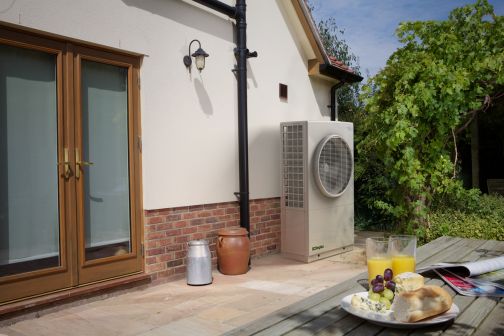Electric Jersey - cut bills and cut carbon

While we cannot cover every eventuality, tariff or usage pattern in this short summation, we can demonstrate how heat pumps can help deliver sustainable, efficient heating and hot water solutions with half the carbon for the domestic market. And this is all achievable at a highly cost-effective rate.
Whilst the technology works on the Island in exactly the same way as in the UK, how it is viewed and accounted for is different. Much more time is spent introducing heat pumps and driving home the advantages of the running costs before anything else.
That is because the carbon intensity of electricity on the Island - based on the current four-year average - is very low, just 0.105Kg/CO²/kWh, according to the Jersey Electric Company. At just 20% of the current UK figure, this is one benefit of being only 14 miles from the French grid.
In the UK, for example, the high carbon intensity of electricity, 0.519Kg/CO²/kWh compared to that of gas at 0.216Kg/CO²/kWh, remains a challenge. However, a heat pump at a Seasonal Co-efficient Of Performance (SCOP) of just 300%, satisfying the space/water heating demand of 10,000kWh, produces just 1726Kg/CO² compared to a 90% efficient gas system producing 2399Kg/CO².
That is 28% less CO².
If we compare to a much higher performing heat pump, at say 450% SCOP, the reduction in emissions over gas increases to 52%.
We eagerly await the next revision of Part L, as this will recognise the latest SAP consultation reducing the carbon intensity of electricity even further to just 0.4Kg/CO²/kWh. A reduction of 23%, taking it back to 2009 levels.
If we apply this to our previous calculations, a heat pump performing at 450% SCOP will produce 63% less carbon than its gas equivalent.
This is encouraging, showing how the energy market has continued to develop over the last decade, in tandem with the ability to produce renewable sources of power. This is a critical development for users and consultancies considering heat pumps for their projects.
In 2015, more than a third of the electricity supplied in Jersey was from renewable hydro and it was calculated that electricity was delivered at just 0.033Kg/CO²/kWh. This is compared to local fossil fuels with heating oil at 0.265Kg/CO²2/kWh and LPG at 0.234Kg/CO²/kWh*
This means that by switching to any form of electricity, users will reduce their carbon footprint. So, if low carbon is a given, what else can be done and what are the benefits?
In addition to meeting Part L standards, across Jersey there are specific local planning requirements and standards such as JerseySAP to be adhered too.
Meeting energy demand from a cleaner, greener grid through the implementation of heat pumps leads to a threefold benefit: a reduction in carbon; a reduction in consumption and a reduction operating costs which all translate into happier customers.
However, today’s market is far more sophisticated and whichever of the three you favour, you get the other benefits anyway. Customers are more concerned with energy efficiency because they are conscious of the environment, but for most, a reduction in bills is going to be a big win.
So, let us compare three systems – a gas boiler at 90% efficiency, an oil-fired boiler at 90% efficiency and heat pumps at 300% SCOP – all supplying heating and hot water at a level of 15,000kWh per annum and using published rates for energy on Jersey.

System 1 – Mains Gas using Super Economy 24
15,000kWh / 0.9 = 16,666kWh actual usage
16,666kWh x £0.0924 per unit of gas = £1,539.94
Add £2.04 per day standing charge = £744.60
Total operating cost for Gas = £2,284.54p.a.
Carbon output for Mains Gas 0.216Kg/CO²/kWh
Carbon output for LPG 0.234Kg/CO²/kWh
System 2 – Oil fired heating
15,000kWh / 0.9 = 16,666kWh actual usage
16,666kWh x £0.05 per unit of oil = £833.30
Total operating cost for Oil = £833.30p.a.
Carbon output for Oil 0.265Kg/CO²/kWh
System 3 – Heat Pump at 300% SCOP using Economy 20
13,500kWh @ 300%SCOP = 4,500kWh actual usage
4,500kWh x £0.1022 per kWh = £459.90
1,500kWh x £0.1450 per kWh = £217.50 (top up heating/hot water)
Add daily charge single diff £0.291** = £10.62
Total operating cost for Heat Pumps = £688.02
Carbon output for Electricity 0.105Kg/CO²/kWh
(All costs are inclusive of GST)
*source: SAP Building Calculator as at 30.09.2015
** difference between standard tariff daily charge and heat pump single phase daily charge








